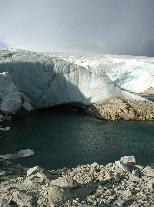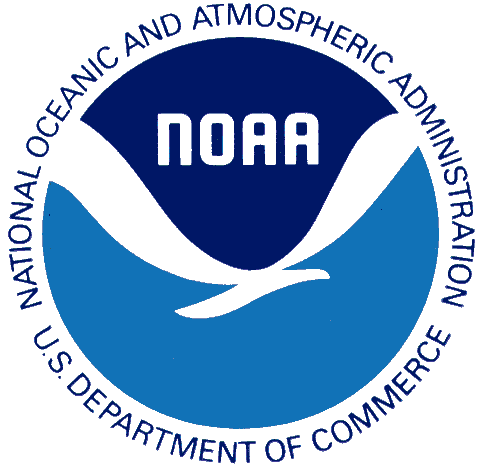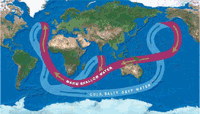 |
|
LAMONT-DOHERTY EARTH OBSERVATORY THE EARTH INSTITUTE AT COLUMBIA UNIVERSITY |
||
| Abrupt Climate Change | ||
| LDEO | ||
| Home | ||
| Divisions | ||
| LDEO Search | ||
| Abrupt CC | ||
| Home | ||
| Q&A | ||
| Contacts | ||
| Research | ||
| Links |
|
back to Q&A 7a: What causes abrupt climate change? It is widely recognized that abrupt climate change is a rapid transition between climate states. There are at least three well-supported hypotheses for the causes of such a jump :
From the point of view of the ocean, the sudden release of freshwater
from a glacial lake is an external forcing, capable of rapidly modifying the
surface circulation in the North Atlantic, and the climate of adjacent regions.A
volcanic eruption or a massive nuclear war would also fall into this category. 2) Slow changes in an external forcing can move the climate system across a threshold For example, the oscillation between glacial and warm conditions results from periodic (hence predictable) changes in the Earth's orbit around the sun. These changes influence the seasonal distribution of solar radiation and can potentially cause abrupt changes in El Niño, monsoons and the global atmospheric circulation. The abrupt shifts, scientists hypothesize, result from crossing thresholds, such as when ice melting rapidly freshens the North Atlantic sea surface, shutting down the ocean thermohaline circulation.
Regardless of their origin, abrupt forcing, smooth forcing or no forcing at all, a fundamental concept to understanding of abrupt climate change is the notion of nonlinearities and multiple equilibria (National Research Council 2002). Click here for more information on the non-linear dynamics of climate
7b: Could it happen as a result of greenhouse warming? Certainly not as described in certain catastrophe movies (Weaver and Hillaire-Marcel, 2004). The premise, however, is not entirely wrong. Most models do predict that the thermohaline circulation will slowdown in the 21st century as a result of greenhouse warming. This is shown below for the bundle of models used for IPCC simulations. The slowdown occurs because of the addition of freshwater to the North Atlantic Ocean making it less dense and less able to sink to depth.
Figure 9.25: Simulated water-volume transport change of the Atlantic "conveyor belt" (Atlantic overturning) in a range of global warming scenarios computed by different climate research centres. Shown is the annual mean relative to the mean of the years (1961-1990) [unit: Sv, 10^6 m^3.s^-1].(Source: IPCC, 2001, chapter 9, p105) The thermohaline circulation contributes to a warmer Northern Hemisphere by transfering heat from the tropics to the subpolar regions. However, the details of this are often misrepresented and exaggerated. A striking feature of winter climates around the North Atlantic is how warm it is in the British Isles and northwest Europe compared to the bitter cold at the same latitudes on the other side in North America (Labrador, Newfoundland and so on). Winter mean temperature differences in these places can be as much as 20 degrees Centigrade. Research has now shown that this temperature difference is primarily explained by two processes: 1) the release in winter of heat stored in the ocean during the previous summer and 2) the prevailing direction of the winds which are themselves influenced by the Rocky Mountains. Because of the requirement for angular momentum conservation, as the winds blow from west to east, the Rockies force them to take a deep dip to the south after crossing the range. The return flow towards the north occurs downstream - over western Europe. Thus, not only does Europe receive mild air from the west warmed by winter heat release from the North Atlantic Ocean but it also gets air blowing up from the south where it is warm. In contrast, eastern North America not only gets cold air coming off a frigid continental interior to its west but it also gets its air from the north where it is really cold! These two processes - seasonal heat storage by the oceans and the pattern of the prevailing winds - explain the huge wintertime temperature difference between western Europe and eastern North America. (A similarly large temperature difference occurs across the North Pacific ocean). The transport of heat by the ocean currents actually warms both sides of the North Atlantic Ocean because this heat is released to the atmosphere preferentially in two places: in the Gulf Stream immediately east of North America where storm systems blow it into America, and between Scotland and Norway where it causes extensive warming that keeps the coast of Norway north of Bergen ice free in winter. At the latitudes of London or Paris, or in eastern North America, the best estimates (based on computer models) are that a complete shutdown of the ocean circulation, or just the thermohaline part, would cause cooling by about 2-4 degrees Centigrade. This would leave a huge difference in winter temperatures between western Europe and eastern North America but would be a rude surprise to Europeans accustomed to mild, damp and dreary winters. The cooling would be much more in Norway as sea ice extends south down the coast. However the ocean circulation cannot stop entirely. The circulation is driven in large part by the winds and these will continue to blow under any climate scenario we know of or can imagine for the future. So, even if freshening of the North Atlantic Ocean causes reduced sinking, the wind-driven circulation will continue to bring warm waters up from the subtropics, warming eastern North America in the process, and across the North Atlantic to ameliorate the climate in parts of western Europe. Exactly how much cooler and if and when this might happen is subject to ongoing debate. So far climate models show a rather gradual slowdown of the thermohaline circulation in the Twenty First century and this means that while western Europe warms less than some other high latitude areas it still warms. However we do not know whether these same models are capable of producing abrupt climate changes and we do not know if they model the details of the thermohaline circualtion correctly. One way to test them would be to see if they can reproduce documented past abrupt changes. Despite these model simulations of the coming century there is still reason to be concerned about what will happen to the real North Atlantic Ocean circulation. A slowdown of the thermohaline circulation alone would cause obvious climate changes and the probability of this occurring and the changes it would cause need to be accurately determined. Two things, however, are rather clear:
If there is one thing you should be worried about, it is more extreme precipitation variability (droughts and floods) rather than the onset of another ice age. (see question 8). ReferencesHäkkinen S, Rhines PB, Decline of subpolar North Atlantic circulation during the 1990s, Science 304 (5670): 555-559 APR 23 2004 Weaver AJ, Hillaire-Marcel C, Global warming and the next ice age, Science, 304 (5669): 400-402 APR 16 2004
|
|
|

NGDC |
Modeling Observations Paleoclimate |

NAS Report on Abrupt Climate Change |

LDEO CORC/ARCHES Project |

The trigger for the Younger Dryas |

Cultural responses to climate change |

Solar influence on climate change |
LDEO home | search | webmaster | site map | terms-of-use | support LDEO
Copyright © 2003 by The Trustees of Columbia University in the City of New York, Lamont-Doherty Earth Observatory.
All rights reserved.
